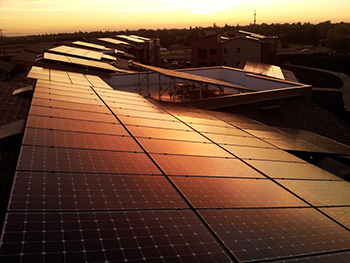Q&A: The Future of Multi-Family Housing Solar Installations
 As the price of solar energy drops, many developers now see solar electricity and solar hot water as a significant way to save energy, which turns into a profitable return on investment. For the past decade, solar energy has also been eligible for incentives, federal tax credits and both federal and state accelerated depreciation schedules. During that time, Berkeley, Calif.’s Sun Light & Power has built the largest number of solar systems for multi-family housing of any company in California. It has installed about 9 megawatts of solar power for more than 150 multi-family housing projects.
As the price of solar energy drops, many developers now see solar electricity and solar hot water as a significant way to save energy, which turns into a profitable return on investment. For the past decade, solar energy has also been eligible for incentives, federal tax credits and both federal and state accelerated depreciation schedules. During that time, Berkeley, Calif.’s Sun Light & Power has built the largest number of solar systems for multi-family housing of any company in California. It has installed about 9 megawatts of solar power for more than 150 multi-family housing projects.
Green Building News spoke with Gary Gerber, Sun Light & Power’s founder, about his experience with multi-family housing solar installations and what developers can expect in terms of the future of the solar energy market.
Q: When did you start seeing a growth in demand for multi-family housing solar installations?
Gerber: I would say it’s been about seven or eight years since we started working in particular nonprofit multi-family housing projects.
Q: Why do you think this growth has happened?
Gerber: What happened in 2006 is that we had the implementation of the Million Solar Roofs solar rebate program. That particular rebate program set aside funds specifically for not-for-profits. The rebate levels recognized the fact that not-for profits were not able to take advantage of federal rebates, which also started that year, and were placed at a serious disadvantage. The state had an interest in promoting solar for income-challenged individuals, so they decided to have a separate, higher rebate level for non-for-profits to help compensate for that, and this opened up the opportunity for these low-income housing developers to add solar. We have relationships with dozens of non-for-profit, low-income housing organizations, and we saw that as a great growth opportunity. It’s also very much in line with our mission as a company to promote solar to disadvantaged communities.
Q: When did that Million Solar Roofs program expire?
Gerber: The rebate program was designed originally as a 10-year, 10-step program. It’s essentially over because the money’s gone after seven years. There’s money left in the Multiple Affordable Solar Housing (MASH) program and that’s getting renewed funding for next year.
Q: Would you say that rebate programs are the main funding behind affordable solar installations?
Gerber: If you’re talking about affordable solar, the rebate program was a major driver for affordable housing solar because that market sector did not have access to the federal tax credit. That rebate became more of a dominant factor in that segment. In the for-profit segment, that’s not so much the case. It was the case early on in the program. It was designed to be a declining rebate, with the hope that installation and material costs would drop over time and so would the rebate. This would create be an increase in the market and that has happened. People who run the program at the state like to take credit for this working out so well. The reality is that the real factors that made this happen are external to our programs in California. The factors are that the German feed-in tariffs created a whole new market worldwide and supported European solar sales. The California market is a relatively small piece of the global market. The pricing of Chinese modules has also been a strong pricing factor, and all modules have dropped in price.
Those factors did work out pretty nicely. If you looked at the net cost after rebate after tax credit of installing a solar system, that cost has actually dropped as well. At the same time, utility prices have gone up. It’s all worked out almost as though someone planned it that way.
Q: What do you see is the future of solar installations?
Gerber: The price is starting to go back up. I think we’re starting to reach the bottom of the trough here. There are certain fundamental material costs that we can’t go below. Once you’re at a point where material costs start becoming predominant, then that puts you into an inflationary cycle. For example, for years in solar hot water market, the cost of a solar hot water collector is not becoming more abundant; it’s becoming more rare. The labor to extract them the energy cost to extract materials is not going down. We should expect a lot more stability in module pricing over time. It might still drop more but if it does, there’s not much room to go.
Q: Based on your experience, what advice do you have regarding installing solar systems of this kind?
Gerber: The No.1 thing is that we run into the question in which clients will say why don’t I just wait because prices are going down. My response to them is that prices seem to be going down but so are the rebates. You’re not coming out ahead by waiting, and that was true. And what’s true today is that prices are not going down and we have no rebates to speak of. Every month you wait you pay a higher utility bill, so what’s the rationality in waiting to save money. You should become a part of the solution and not part of the problem. As a green builder, use your energy efficiency and renewable energy generation as a distinguisher for your business
